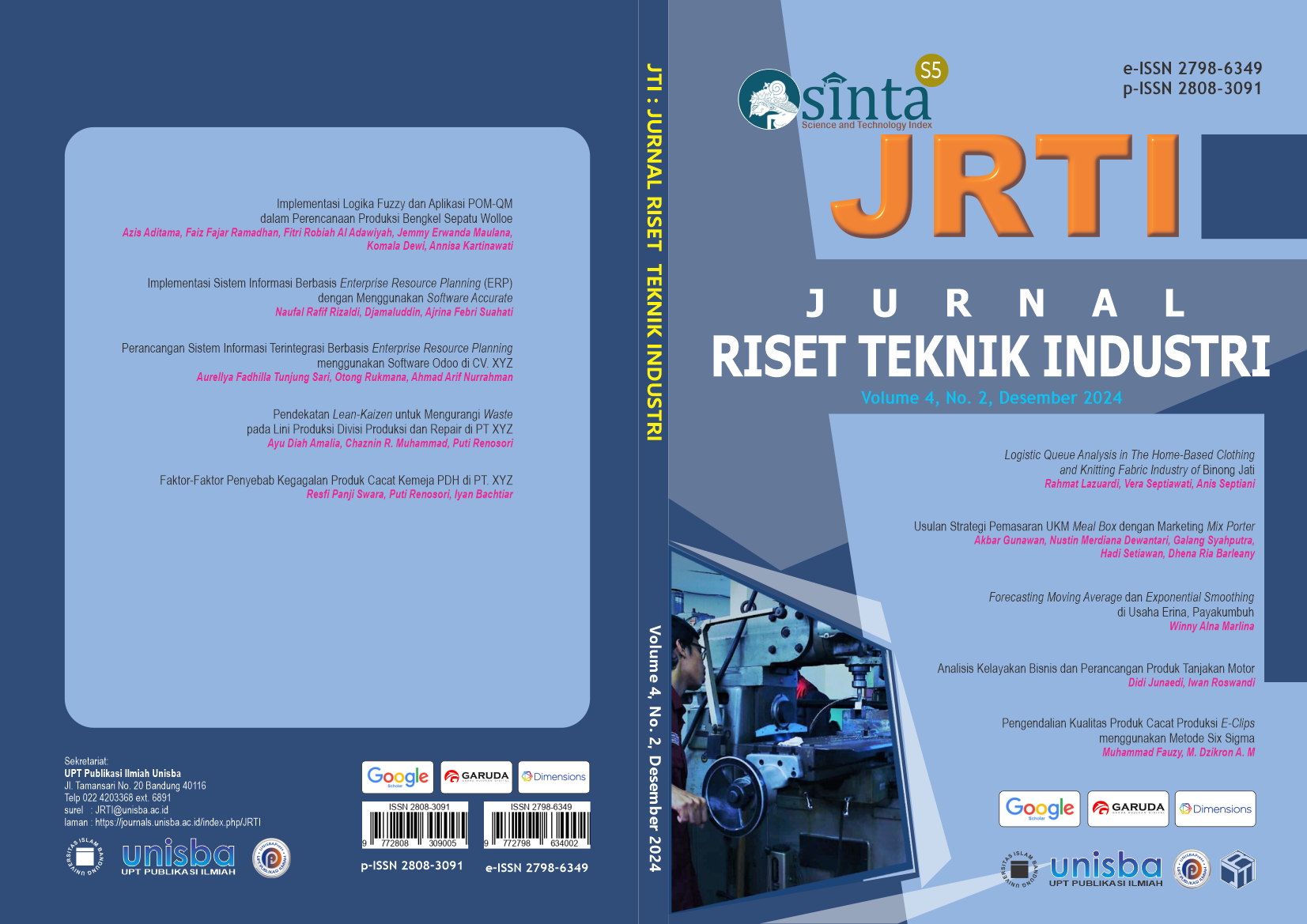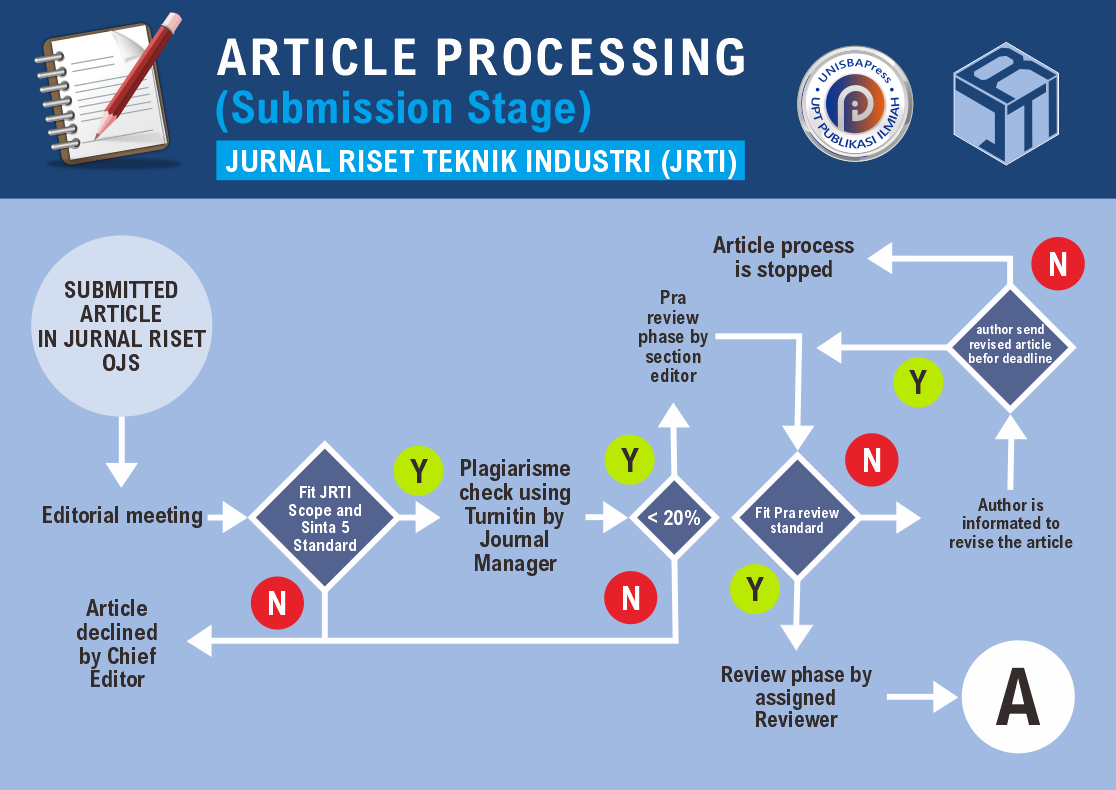Logistic Queue Analysis in The Home-Based Clothing and Knitting Fabric Industry of Binong Jati
DOI:
https://doi.org/10.29313/jrti.v4i2.4420Keywords:
Poisson, Exponential, Poisson, exponential, Kolmogorov-Smirnov test.Abstract
Abstrak Tujuan dari penelitian ini adalah untuk melakukan analisis komprehensif dan memperoleh wawasan optimal terkait antrean logistik dalam industri pakaian dan kain rajut Penelitian ini bertujuan menganalisis serta mencari kesimpulan optimal pada antrian logistik di industri rumahan pakaian dan kain rajutan di Binong Jati. Pendekatan studi menggunakan distribusi Poisson dan eksponensial untuk menganalisis data waktu tunggu dari berbagai tahap seperti produksi, penyimpanan, pengemasan, dan pengiriman produk. Uji Kolmogorov-Smirnov digunakan untuk memeriksa kesesuaian data dengan distribusi tersebut. Metode ini melibatkan pengumpulan data dan analisis statistik guna mengidentifikasi tantangan utama di industri ini. Hasil analisis diharapkan menunjukkan kesesuaian yang signifikan antara data waktu tunggu dan kedua distribusi. Implikasinya adalah peningkatan perencanaan produksi, pengelolaan persediaan, dan penjadwalan pengiriman produk untuk memperbaiki kinerja dan kepuasan pelanggan. Rasio kecocokan kedua model distribusi, Poisson dan eksponensial, dengan Uji Kolmogorov-Smirnov adalah sebesar 0,062 dan 0,057. Batasannya adalah keterbatasan dalam hanya menggunakan dua distribusi, sehingga penelitian mendatang diharapkan dapat mengeksplorasi pendekatan distribusi lainnya.
Abstract This research aims to analyse and find optimal conclusions regarding logistics queues in the home-based clothing and knitted fabric industry in Binong Jati. The study's approach employs Poisson and exponential distributions to analyse waiting time data from various stages such as production, storage, packaging, and product delivery. The Kolmogorov-Smirnov test is used to assess data suitability for these distributions. This method involves data collection and statistical analysis to identify key challenges in this industry. The analysis results are expected to show significant concurrence between wait time data and both distributions. The implications include improved production planning, inventory management, and product delivery scheduling to enhance performance and customer satisfaction. The goodness-of-fit ratio for the Poisson and exponential distribution models with the Kolmogorov-Smirnov test is 0.062 and 0.057, respectively. The limitation lies in the use of only two distributions, thus future research is expected to explore other distribution approaches.
References
R. Hendayani, Mari Berkenalan Dengan Manajemen Logistik. Bandung: CV. Alfabeta, 2011.
H. Gunawan, Pengantar Transportasi dan Logistik. Jakarta: PT. Raja Grafindo Persada, 2014.
A. Penttinen and E. Nyberg, “Chapter 8 – Queueing Systems, Lecture Notes: S-38.145 - Introduction to Teletraffic Theory,” 2003. [Online]. Available: http://www.netlab.hut.fi/opetus/s38145/
Jay. Heizer, Barry. Render, and Chuck. Munson, Operations management : sustainability and supply chain management. Pearson, 2020.
M. A. Nggole, Yan Orgianus, and Eri Achiraeniwati, “Usulan Rancangan Perbaikan Pengelolaan Laboratorium Berdasarkan Hasil Gap Analysis dengan ISO 9001:2015 pada Laboratorium Teknik Industri Universitas Islam Bandung,” Jurnal Riset Teknik Industri, vol. 1, no. 1, pp. 88–95, Oct. 2021, doi: 10.29313/jrti.v1i1.234.
W. D. , S. R. P. , Z. N. B. Kelton, “Simulation with Arena,” New York, 2015. [Online]. Available: http://www.goldsim.com/Content.asp?PageID=603
I. Dimitriou, E. Morozov, and T. Morozova, “A Multiclass Retrial System with Coupled Orbits and Service Interruptions: Verification of Stability Conditions,” in 2019 24th Conference of Open Innovations Association (FRUCT), IEEE, Apr. 2019, pp. 75–81. doi: 10.23919/FRUCT.2019.8711879.
M. Laguna and J. Marklund, Business Process Modeling, Simulation and Design. Third Edition. | Boca Raton, FL : CRC Press, [2019] | Revised edition of the authors’ Business process modeling, simulation, and design, [2013]: Chapman and Hall/CRC, 2018. doi: 10.1201/9781315162119.
J. Thomas. Kakiay, Dasar Teori Antrian untuk Kehidupan Nyata. Yogyakarta: ANDI, 2004.
W. Hall. Randolph, Queueing Methods for Services and Manufacturing. USA: Prentice Hall, 2013.
P. Siagian, Penelitian Operasional : Teori dan Praktek. Jakarta: Universitas Indonesia, 1987.
Sudaryono, Teori dan Aplikasi dalam Statistik. Yogyakarta: Andi, 2014.
J. Supranto, Statistika: Teori dan Aplikasi, 8th ed. Jakarta: Erlangga, 2016.
K. Santhi and R. Saravanan, “Performance analysis of cloud computing using series of queues with Erlang service,” International Journal of Internet Technology and Secured Transactions, vol. 9, no. 1/2, p. 147, 2019, doi: 10.1504/IJITST.2019.098167.
J. & N. S. R. Susetyo, Analisis Sistem Antrian Multiple Channel untuk Kapasitas Terbatas. Jakarta: Universitas Pancasila Jakarta, 2017.
A. S. & B. H. Tanenbaum, Modern Operating Systems. 2015.
R. & H. J. Bronson, Theory and Problems of Operations Research. The Journal of the Operational Research Society, 1983.
W. D. Barros Simões, J. G. Vidal Vieira, and R. L. Magalhães de Oliveira, “On causal links of the municipal concentration of logistics warehouses,” Transp Policy (Oxf), vol. 149, pp. 271–281, Apr. 2024, doi: 10.1016/j.tranpol.2024.02.018.












